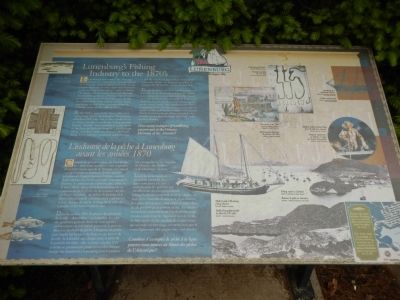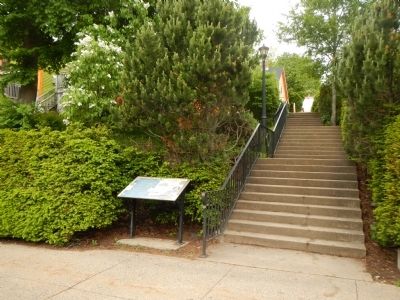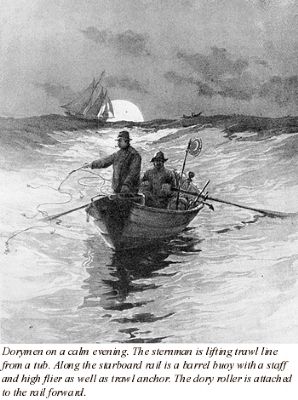Lunenburg in Lunenburg County, Nova Scotia — The Atlantic Provinces (North America)
Lunenburg’s Fishing Industry to the 1870’s
L’industrie de la pêche à Lunenburg avant les années 1870
Inscription.
English
Lunenburg’s early settlers, the “Foreign Protestants,” came from a rich agricultural area in Europe and it was planned that they should establish farms which could supply both their own needs and those of the colony’s capital at Halifax. The land could not sustain them and although they lacked experience in fishing, Lunenburgers soon became accomplished fishermen. At first they pursued the shore fishery and later began exploiting the rich fishing grounds along the Labrador coast and the offshore banks.
By the 1820’s, most of the Town’s fishermen were going “down the Labrador.” Every June, schooners each with two or three smaller boats or whalers would set out for the fishing grounds. Fishing “stations” were established on the shores of the bays and harbours along the Labrador coast where each day’s catch was cleaned, salted and dried. These activities continued until October when the vessels returned to Lunenburg from where the salt fish were shipped to markets in Europe, the West Indies and South America.
The Banks fishery involved handlining for cod from the decks of schooners fishing in shallow waters along the continental shelf or the “banks” off Nova Scotia and Newfoundland. Each day’s catch was cleaned and salted while wet or “green” in the vessel’s hold. The vessel returned to Lunenburg where the fish were set out to dry on raised wooden racks known as flakes. This process which involved a heavy salting provided a less desirable product than the lightly salted cod “made” on the Labrador.
How may examples of handlining can you spot at the Fisheries Museum of the Atlantic?
French
Comme les premier colons de Lunenburg, les «protestants étrangers», sont originaires d’une riche région agricole de l’Europe, on s’attend à ce qu’ils puissent établir des fermes qui leur permettront d’approvisionner Halifax, capitale de la colonie, en plus de subvenir à leurs propres besoins. Cependant, ils n’arrivent pas à vivre de la terre. Alors, même si les Lunenbourgeois ne connaissent pas la pêche, ils deviennent vite de pêcheurs accomplis. Au début, ils pratiquent la pêche côtière, puis ils commencent à exploiter les riches champs du pêche le long de la côte du Labrador et les bancs en haute mer.
Dan les années 1820, la plupart de pêcheurs de la ville «descendent» au Labrador. En juin, des goélettes portant deux ou trois petites embarcations ou baleinières prennent la mer en direction de bancs de pêche. Des postes de pêche sont établis sur les rives de baies et des havres de la côte du Labrador où, chaque jour, la prise de la journée est vidée, salée, et mise
à sécher. Ces activités se poursuivent jusqu’en octobre l'orque les bateaux retournent à Lunenburg d’où le poisson salé est expédié sur les marchés de l’Europe, des Antilles et de l’Amérique du Sud.
La pêche sur les bancs est une pêche manuelle. Des lignes sont jetées à la mer à parter du pont des goélettes qui mouillent dans les eaux peu profondes le long de plateau continental ou sur les «bancs» au large de la Nouvelle-Écosse et de Terre-Neuve. Les prises de la journée sont vidées et salées dans la cale pendant que la poisson est frais. Les bateaux retournent à Lunenburg où le poisson est ensuite étendu à sécher sur le vigneaux, sont des treillis de bois surélevés. Le produit de ce processus qui nécessite un fort salage, est moins bon que la morue légèrement salée qui est «faite» au Labrador.
Combien d’exemples de pêche à la ligne pouvez-vous trouver au Musée des pêches de l’Atlantique?
Erected by Town of Lunenburg.
Topics. This historical marker is listed in these topic lists: Industry & Commerce • Waterways & Vessels. A significant historical year for this entry is 1820.
Location. 44° 22.582′ N, 64° 18.759′ W. Marker is in Lunenburg, Nova Scotia, in Lunenburg County. Marker is on Bluenose Drive close to Cornwallis Street, on the right when traveling west. Touch for map. Marker is in this post office area: Lunenburg NS B0J, Canada. Touch for directions.
Other nearby markers. At least 8 other markers are within walking distance of this marker. Old Town Lunenburg Historic District (about 90 meters away, measured in a direct line); Merligueche (about 120 meters away); Lunenburg’s Fishing Industry 1870’s - 1940’s (about 120 meters away); The Early Acadian History of Lunenburg (about 120 meters away); Foreign Protestant Settlement in Lunenburg (about 150 meters away); Lunenburg’s Fishing Industry Since 1940’s (about 150 meters away); The Labrador Whaler Anderson Bros. (about 150 meters away); First Peoples (about 180 meters away). Touch for a list and map of all markers in Lunenburg.
More about this marker. This marker is located on Bluenose Drive at the bottom of the stairs leading to Cornwallis Street.
Also see . . . History of Commercial Fisheries - The Canadian Encyclopedia. Fisheries drew the first Europeans to what is now Canada, and still sustain large coastal and inland regions. The industry is defined by cycles of “boom and bust”, with fishermen enjoying periods of plentiful harvest and financial gain, only to suffer through periods of hardship and unemployment. (Submitted on October 24, 2014, by Barry Swackhamer of Brentwood, California.)
Credits. This page was last revised on July 24, 2020. It was originally submitted on October 24, 2014, by Barry Swackhamer of Brentwood, California. This page has been viewed 521 times since then and 10 times this year. Photos: 1, 2, 3. submitted on October 24, 2014, by Barry Swackhamer of Brentwood, California. • Andrew Ruppenstein was the editor who published this page.


